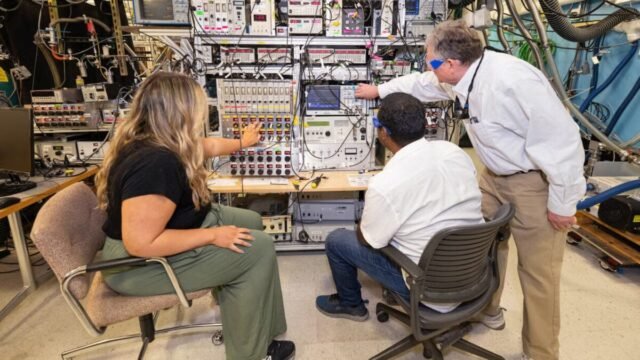For more than two centuries, scientists have known that water carries a positive charge through protons. But they had never seen it happen – until now.
In a Science paper published Sept. 11, Yale researchers reported that they had developed a method to track, measure, and effectively “see” a proton’s journey through water. For the experiment, the team used a 30-foot-long mass spectrometer—an instrument that separates different elements by mass—that took years to customize and refine. The device allowed them to benchmark how quickly protons moved through six charged water molecules.
“We show what happens in a tiny molecular system to release the
Solving a seemingly obvious mystery
There is a surprisingly long list of things in science that we know, or strongly suspect, to be true, but which have either never been directly confirmed or lack a good explanation.
That hasn’t stopped scientists and engineers from using these yet-to-be-confirmed ideas to make remarkable advances. For example, protons in water play a role in “everything from vision to energy storage to rocket fuel,” the researchers explained.
But protons are terribly small and have quantum mechanical properties that make them difficult to measure.
“They’re not polite enough to stay in one place long enough to allow us to easily observe them,” Johnson said. “They are thought to conduct charge through an atomic-scale relay mechanism in which protons pass from molecule to molecule.”
Trapped in an organic “taxi”
To observe such processes in action, Johnson and his team used 4-aminobenzoic acid, an organic molecule that can take up an extra proton at two different sites. The two sites can be distinguished by the color of the light they absorb, study lead author Payten Harville, a postdoctoral fellow at Yale, said in a statement.
For the experiment, the team attached 4-aminobenzoic acid molecules to six water molecules. Harville explained that in this setup, protons can only “get from one docking site to another [by hitching a ride] through the water network like a taxi.”
When protons “catch” on the taxi, the team’s specialized mass spectrometer “destructively” analyzes each reaction ten times a second with carefully timed lasers, the researchers explained.
To be clear, the experiment still hasn’t captured the intermediate steps of the proton’s path through water. However, it does establish the most rigorous parameters of the process yet, Johnson said.
“We are able to provide parameters that will give theorists a well-defined target for their chemical simulations that are ubiquitous but not challenged by experimental benchmarks,” he added.
Indeed, if this technology could be scaled up beyond Yale’s custom spectrometer, it could provide an additional boost to the precision of experiments in fundamental chemistry. Given how it’s taken 200 years of science to get to this point, a couple more to really pilot this method should be a shorter wait.















